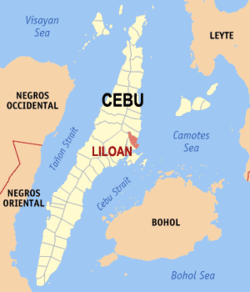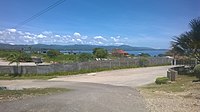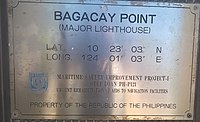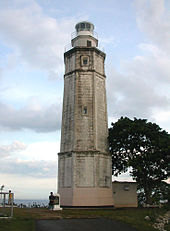Liloan, Cebu
Liloan | |
|---|---|
| Municipality of Liloan | |
 From Suba bridge | |
 Map of Cebu with Liloan highlighted | |
show OpenStreetMap | |
 Liloan Location within the Philippines | |
| Coordinates: 10°25′N 123°58′E / 10.42°N 123.97°ECoordinates: 10°25′N 123°58′E / 10.42°N 123.97°E | |
| Country | Philippines |
| Region | Central Visayas |
| Province | Cebu |
| District | 5th district |
| Founded | 1845 |
| Barangays | 14 (see Barangays) |
| Government | |
| • Type | Sangguniang Bayan |
| • Mayor | Ma. Esperanza Christina G. Frasco |
| • Vice Mayor | Thelma L. Jordan |
| • Representative | Vincent Franco D. Frasco |
| • Municipal Council | show
Members |
| • Electorate | 72,620 voters (2019) |
| Area | |
| • Total | 45.92 km2 (17.73 sq mi) |
| Elevation | 20 m (70 ft) |
| Highest elevation | 231 m (758 ft) |
| Lowest elevation | 0 m (0 ft) |
| Population (2020 census) [3] | |
| • Total | 153,197 |
| • Density | 3,300/km2 (8,600/sq mi) |
| • Households | 27,722 |
| Economy | |
| • Income class | 1st municipal income class |
| • Poverty incidence | 14.66% (2015)[4] |
| • Revenue | ₱226,110,226.09 (2016) |
| Service provider | |
| • Electricity | Visayan Electric Company (VECO) |
| Time zone | UTC+8 (PST) |
| ZIP code | 6002 |
| PSGC | |
| IDD : area code | +63 (0)32 |
| Climate type | tropical monsoon climate |
| Native languages | Cebuano Tagalog |
| Website | www |
Liloan, officially the Municipality of Liloan (Cebuano: Lungsod sa Liloan; Tagalog: Bayan ng Liloan), is a 1st class municipality in the province of Cebu, Philippines. According to the 2020 census, it has a population of 153,197 people. [3] Liloan lies within Metro Cebu.
Liloan is bordered on the north by the town of Compostela, to the west by Cebu City, on the east by the Camotes Sea, and on the south by the town of Consolacion.
History[]
This section does not cite any sources. (January 2009) |
Along its coastline, there is spot called Silot, where a whirlpool is created by the ebbs and flows of the waters from the bay. This phenomenon is called lilo in Cebuano. Because of this, the town was known as Liloan, meaning "a place where there is a lilo".
Some time in the 1970s, a newspaper article stated that the "pueblo de Lilo‑an" was separated from the municipality of Mandaue (now Mandaue City), and was created a new municipality in 1840. However, in his "Breve reseña de lo que fue y de lo que es la Diócesis de Cebú en las Islas Filipinas," Redondo (1886) states that Lilo‑an was created as a parish in 1845 (in 1995, Lilo‑an celebrated its sesquicentennial - 150th – anniversary.)
The creation of the municipality of Lilo‑an could have been at the same time the parish was established, but not earlier than its being a parish. As recorded, the first priest of Lilo‑an served in 1845. The term of the first mayor was from 1845 to 1846.
During the war years (World War II), Lilo‑an had three mayors at one time. The elected mayor was Catalino Noval. The Japanese Occupation Forces appointed another, Pascual Delgado. Not to be outdone, the Guerilla Forces also designated another, Jose Cañete.
Cityhood[]
House Bill No. 5031 was filed last October 2, 2019 for the conversion of the municipality of Liloan into a component city in the province of Cebu.[5] The bill is currently pending with the committee on local government since November 4, 2019.
Barangays[]
Liloan comprises 14 barangays:
| PSGC | Barangay | Population | ±% p.a. | |||
|---|---|---|---|---|---|---|
| 2020 [3] | 2010 [6] | |||||
| 072227001 | Cabadiangan | 1.3% | 1,982 | 1,790 | 0.99% | |
| 072227002 | Calero | 3.5% | 5,315 | 4,513 | 1.59% | |
| 072227003 | Catarman | 10.3% | 15,829 | 14,839 | 0.63% | |
| 072227004 | Cotcot | 4.4% | 6,796 | 5,185 | 2.65% | |
| 072227005 | Jubay | 7.8% | 11,931 | 8,819 | 2.96% | |
| 072227006 | Lataban | 1.5% | 2,245 | 1,863 | 1.82% | |
| 072227007 | Mulao | 0.7% | 1,067 | 952 | 1.11% | |
| 072227008 | Poblacion | 9.8% | 15,041 | 13,371 | 1.14% | |
| 072227009 | San Roque | 1.0% | 1,521 | 1,331 | 1.30% | |
| 072227010 | San Vicente | 6.7% | 10,219 | 8,665 | 1.61% | |
| 072227011 | Santa Cruz | 1.4% | 2,203 | 1,899 | 1.44% | |
| 072227012 | Tabla | 0.9% | 1,423 | 1,189 | 1.75% | |
| 072227013 | Tayud | 10.3% | 15,814 | 13,616 | 1.46% | |
| 072227014 | Yati | 17.9% | 27,367 | 22,468 | 1.92% | |
| Total | 153,197 | 100,500 | 4.15% | |||
Climate[]
| hideClimate data for Liloan, Cebu | |||||||||||||
|---|---|---|---|---|---|---|---|---|---|---|---|---|---|
| Month | Jan | Feb | Mar | Apr | May | Jun | Jul | Aug | Sep | Oct | Nov | Dec | Year |
| Average high °C (°F) | 28 (82) |
29 (84) |
30 (86) |
31 (88) |
31 (88) |
30 (86) |
30 (86) |
30 (86) |
30 (86) |
29 (84) |
29 (84) |
28 (82) |
30 (85) |
| Average low °C (°F) | 23 (73) |
23 (73) |
23 (73) |
24 (75) |
25 (77) |
25 (77) |
25 (77) |
25 (77) |
25 (77) |
25 (77) |
24 (75) |
23 (73) |
24 (75) |
| Average precipitation mm (inches) | 70 (2.8) |
49 (1.9) |
62 (2.4) |
78 (3.1) |
138 (5.4) |
201 (7.9) |
192 (7.6) |
185 (7.3) |
192 (7.6) |
205 (8.1) |
156 (6.1) |
111 (4.4) |
1,639 (64.6) |
| Average rainy days | 13.4 | 10.6 | 13.1 | 14.5 | 24.2 | 27.9 | 28.4 | 27.7 | 27.1 | 27.4 | 22.5 | 15.9 | 252.7 |
| Source: Meteoblue [7] | |||||||||||||
Demographics[]
| Year | Pop. | ±% p.a. |
|---|---|---|
| 1903 | 10,024 | — |
| 1918 | 19,842 | +4.66% |
| 1939 | 13,662 | −1.76% |
| 1948 | 12,292 | −1.17% |
| 1960 | 16,424 | +2.44% |
| 1970 | 22,495 | +3.19% |
| 1975 | 26,492 | +3.33% |
| 1980 | 30,196 | +2.65% |
| 1990 | 42,587 | +3.50% |
| 1995 | 50,973 | +3.43% |
| 2000 | 64,970 | +5.34% |
| 2007 | 92,606 | +5.01% |
| 2010 | 100,500 | +3.02% |
| 2015 | 118,753 | +3.23% |
| 2020 | 153,197 | +5.14% |
| Source: Philippine Statistics Authority [8] [6] [9][10] | ||
Economy[]
| Poverty Incidence of Liloan | |
| Source: Philippine Statistics Authority[11][12][13][14][15][16] | |
The economy of Liloan relies mostly on baking, being the birthplace of the Rosquillos cookie and center of Titay's, the largest Rosquillos company in the Philippines. There are other sources of livelihood in the town such as fishing and tourism.
Liloan is also home to a number of ceramics manufacturers. Their shops sell a variety of ceramic items: from ordinary plant pots, to bricks, and even exotic jars.
Landmarks[]
Lighthouse[]
One of the best known landmarks in Lilo‑an is its historic lighthouse at Bagacay Point. The original lighthouse was built in 1857 by the Spanish. The current tower was constructed in 1904 by order of William Howard Taft,[17] the first Governor-General of the Philippines and later the President of the United States. The tower is 22 metres (72 ft) tall and remains in active use today, using solar energy.[18] The lighthouse was declared a National Historical Landmark in 2004 by the National Historical Commission of the Philippines (formerly known as National Historical Institute).[19]
Liloan Church (San Fernando Rey Parish Church)[]

The designer of the church in Liloan is viewed by some as visionary. Despite Liloan having only 5,000 citizens, when the church was constructed in 1847, this local church was even larger than that of Mandaue, Cebu's second largest city.
One unusual detail about the church in Liloan is that it faces the mountains to the west, whereas most churches face the sea to the east. Some have theorized that this is because Mass is often performed in the morning; and the church is thus shielded from the morning sun, making it less hot and uncomfortable. Others have speculated that the church's direction has a symbolic significance related to church rites.
Titay's Rosquillos and Delicacies[]
The making of these little ringlet cookies dates back to 1907, when 21-year-old Margarita "Titay" (single, unmarried) was tinkering in her kitchen with her baking ingredients and made her new culinary creation. Kneading the dough manually and using a wooden eggbeater, some baking tins and a clay oven, she started a product that would put her little town in the national and international map of gastronomic delight.
The market for her unnamed cookie started with her neighbors and passers-by who were offered the snack with a bottle of soda. It was Sergio Osmeña (then Cebu governor, who later became Philippine president), who gave it the name "rosquillos" after the Spanish word rosca.
The biscuits have been a regular stopover of tourists and locals travelling north of Cebu. The company has withstood the taste of time. It started with just rosquillos and tablea making.[a] It later expanded to an array of homemade delicacies including torta, mamon, monay, otap, CPA (chicken pork adobo), bao-bao and more.
Tourism[]
Rosquillos Festival[]
Celebrated every last week of May in honor of the town's patron saint, St. Ferdinand III. It celebrates the Rosquillos as the delicacy of Liloan and of Cebu. The festival has helped the Rosquillos become a household name in Cebu, a product that is celebrated and highlighted in a Cebuano festival that Liloan could call its very own.

List of heads of local government[]
- Basilio Bantilan (1845 - 1846)
- Hipolito Pepito (1846 - 1847)
- Francisco Cabahug (1847 - 1848 and 1859 - 1860)
- Esteban Cañete (1848 - 1849, 1850 - 1851 and 1852 - 1853)
- Juan Delgado (1849 - 1850)
- Juan Cabatingan (1851 - 1852 and 1861 - 1862)
- Cruz Mendoza (1853 - 1855 and 1860 - 1861)
- Alberto Yungco (1855 - 1857)
- Victor Pepito (1857 - 1858, 1863 - 1865 and 1875 - 1879)
- Pedro Pepito (1858 - 1859 and 1862 - 1863)
- Felix Cabatingan (1865 - 1867)
- Jacinto Cañete (1867 - 1869)
- Apolonio Pilapil (1869 - 1871)
- Custodio Mendoza (1871 - 1873, 1883 - 1885 and 1899 - 1900)
- Guillermo Pepito (1873 - 1875)
- Ambrosio Pepito (1879 - 1881)
- Eugenio Pilapil (1881 - 1883 and 1889 - 1891)
- Mamerto Cabatingan (1883 - 1887 and 1891 - 1893)
- Sotero Cabatingan (1887 - 1889, 1900 - 1902 and 1905 - 1909)
- Antonio Villamor (1893 - 1896)
- Simeon Pilapil (1896 - 1898)
- Mariano Pilapil (1898 - 1899)
- Blas Cabatingan (1902 - 1904)
- Marcelo Pilapil (1909 - 1911)
- Francisco Ramas (1911 - 1912)
- Jose Cabatingan (1912 - 1916)
- Cirilo Ramas (1916 - 1919)
- Cipiriano Jumapao (1919 - 1922)
- Florintino Pilapil (1922 - 1925)
- Santiago Noval (1925 - 1928)
- Lararo Ramas (1928 - 1937, 1937 - 1938, 1959 - 1963 and 1963 - 1965)
- Catalino Noval (1941 - 1945, 1945 - 1946 and 1965 - 1967)
- Jorge Pitogo (1946 - 1947 and 1947 - 1951)
- Fabian Cañete (1951 - 1955)
- Teofilo Ponce (1967 - 1971)
- Cesar Bugtai (1971 - 1986)
- Achilles Cañete (1986 - 1988 and 1988 - 1992)
- Panphil Frasco (1992 - 1995, 1995 - 1998 and 1998 - 2001)
- Maria Sevilla (2001 - 2004 and
- 2004 - 2007)
- Duke Frasco (2007 - 2016)
- Christina Garcia-Frasco (2016–Present)
Gallery[]

Miniature Lighthouse Sculpture at the Main Crossroad

San Fernando Rey Church

From Suba Bridge

Looking towards Compostela

Bagacay Lighthouse – Plaque

Bagacay Lighthouse
See also[]
- Liloan, Southern Leyte - a municipality in Southern Leyte
- Liloan - a barangay in Santander, Cebu
Notes[]
- ^ pure cacao beans that are dried, roasted, ground and then formed into tablets
References[]
- ^ Municipality of Liloan | (DILG)
- ^ "2015 Census of Population, Report No. 3 – Population, Land Area, and Population Density" (PDF). Philippine Statistics Authority. Quezon City, Philippines. August 2016. ISSN 0117-1453. Archived (PDF) from the original on May 25, 2021. Retrieved July 16, 2021.
- ^ Jump up to: a b c Census of Population (2020). "Region VII (Central Visayas)". Total Population by Province, City, Municipality and Barangay. PSA. Retrieved 8 July 2021.
- ^ https://psa.gov.ph/sites/default/files/City%20and%20Municipal-level%20Small%20Area%20Poverty%20Estimates_%202009%2C%202012%20and%202015_0.xlsx; publication date: 10 July 2019; publisher: Philippine Statistics Authority.
- ^ Frasco, Vincent Franco. "AN ACT CONVERTING THE MUNICIPALITY OF LILOAN IN THE PROVINCE OF CEBU INTO A COMPONENT CITY TO BE KNOWN AS THE CITY OF LILOAN" (PDF). House of Representatives. Retrieved April 20, 2021.
- ^ Jump up to: a b Census of Population and Housing (2010). "Region VII (Central Visayas)". Total Population by Province, City, Municipality and Barangay. NSO. Retrieved 29 June 2016.
- ^ "Liloan: Average Temperatures and Rainfall". Meteoblue. Retrieved 10 May 2020.
- ^ Census of Population (2015). "Region VII (Central Visayas)". Total Population by Province, City, Municipality and Barangay. PSA. Retrieved 20 June 2016.
- ^ Censuses of Population (1903–2007). "Region VII (Central Visayas)". Table 1. Population Enumerated in Various Censuses by Province/Highly Urbanized City: 1903 to 2007. NSO.
- ^ "Province of Cebu". Municipality Population Data. Local Water Utilities Administration Research Division. Retrieved 17 December 2016.
- ^ "Poverty incidence (PI):". Philippine Statistics Authority. Retrieved 28 December 2020.
- ^ https://psa.gov.ph/sites/default/files/NSCB_LocalPovertyPhilippines_0.pdf; publication date: 29 November 2005; publisher: Philippine Statistics Authority.
- ^ https://psa.gov.ph/sites/default/files/2003%20SAE%20of%20poverty%20%28Full%20Report%29_1.pdf; publication date: 23 March 2009; publisher: Philippine Statistics Authority.
- ^ https://psa.gov.ph/sites/default/files/2006%20and%202009%20City%20and%20Municipal%20Level%20Poverty%20Estimates_0_1.pdf; publication date: 3 August 2012; publisher: Philippine Statistics Authority.
- ^ https://psa.gov.ph/sites/default/files/2012%20Municipal%20and%20City%20Level%20Poverty%20Estima7tes%20Publication%20%281%29.pdf; publication date: 31 May 2016; publisher: Philippine Statistics Authority.
- ^ https://psa.gov.ph/sites/default/files/City%20and%20Municipal-level%20Small%20Area%20Poverty%20Estimates_%202009%2C%202012%20and%202015_0.xlsx; publication date: 10 July 2019; publisher: Philippine Statistics Authority.
- ^ Philippines' Light to Get Makeover
- ^ Bagacay Point Light
- ^ Declaring of Bagacay Point Lighthouse in Liloan, Cebu a National Historical Landmark
Sources[]
- Gonzales, Glenda R. (December 2004). "Metro Cebu: A Metropolitan Area in Need of Coordinative Body" (PDF). Discussion Paper. 2004-49. PIDS. Archived (PDF) from the original on 10 March 2016. Retrieved 16 February 2016.
- Sendino y Redondo, Felipe (1886). Breve reseña de lo que fue y de lo que es la Diócesis de Cebú en las Islas Filipinas (in Spanish). Manila: Colegio de Santo Tomas.
External links[]
| Wikimedia Commons has media related to Liloan. |
- Municipalities of Cebu
- Municipalities in Metro Cebu








